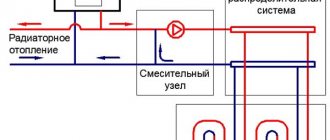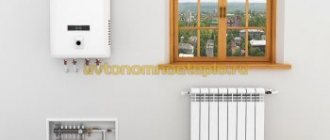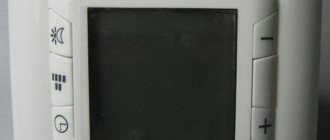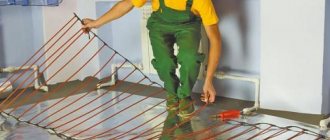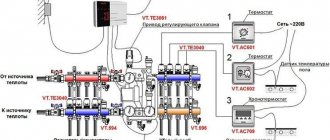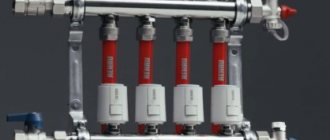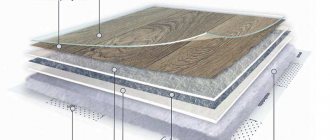When thinking about whether it is possible to connect a heated floor without a thermostat, you should find out not only the opinion of a specialist, but also inquire about the design features, connection specifics and functionality of the system.
It is important not only to feel comfortable when stepping on a heated floor, which should not be too hot or cold due to low heating.
It is necessary to take care of saving energy and, accordingly, your own money. All this can be achieved by following the established rules and following the recommendations of experienced craftsmen.
Design features and functionality
Is it possible to connect a heated floor without a thermostat? Even if someone says that it is possible, an experienced master will answer no. The thermostat is an important component of the design.
Installation and use of additional equipment is carried out even before the pipe contours or heating mats are hidden by the finishing floor covering.
There are several objective reasons why installing a thermostat is considered necessary:
- A heated floor installed without a thermostat does not provide full comfort during its operation. It all depends on the design of the floor itself, what is used as a heating element, and what the maximum heating temperature is. If the coating heats up too much, then the thermostat will help regulate the heating and create the desired temperature in the room.
Operating a heated floor without a regulator will lead to overload of the heating element
- The constant operation of the underfloor heating system leads to the fact that the consumer is faced with increased energy costs. Timely and correct installation of the temperature sensor will allow you to set the desired level of heating of the system and, thus, save energy and material resources. The presence of such equipment will make it possible to refuse to connect the heated floor directly to the home network through an outlet, which means that the electricity consumption will not be constant, but through the “on”-“off” system. The smart device itself is able to turn off the equipment when the desired temperature level is reached.
- Caring for devices extends their service life. This also applies to the use of finishing floor coverings, which will deteriorate much faster if heating is carried out constantly.
Thermostat functions
Of course, when connecting underfloor heating to electricity, you can do without a thermostat - the system will still be able to work. But this approach has many more disadvantages than advantages.
The main task of the temperature sensor is to maintain the user-specified temperature in the room. Moreover, this happens automatically, without the intervention of the owners.
Thus, there is no need to constantly monitor the heating level of the room and manually turn the heated floor on or off. Another plus is safety. It is known that it is quite dangerous to leave the system on when leaving the house, so it is usually turned off. And when the owners return home in the evening, they find themselves in cold rooms. This is especially true in winter, when rooms quickly cool down.
Therefore, a temperature sensor is connected, at a minimum, for reasons of comfort.
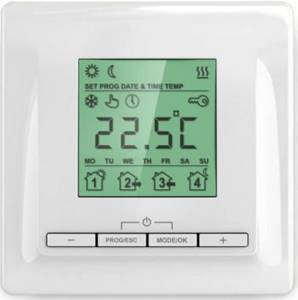
Thermostat
Why do you need a thermostat?
The quality of room heating depends on what system is installed to provide it and what floor covering is laid on top.
Connecting the heated floor directly to the outlet guarantees the constant operation of the units, which means constant exposure to heat on the material laid as a covering.
The thermostat ensures optimal and precise control of cable systems designed for heating and heating applications. It is able to protect both the floor covering and the heated floor system itself from damage.
If laminate, carpet or linoleum is laid on the floor, the continuous flow of heat will lead to rapid failure of the floor covering and its rapid replacement. The laminate will begin to dry out, the seams and joints will separate and cracks will appear.
Ways to control the temperature of a heated floor
To ensure the specified requirements of sanitary and technological standards, user preferences, the heated floor can be adjusted using the following adjustment methods:
- temperature of the coolant entering the TP system. The main control of the heat flow intensity is carried out by changing the settings of the heat generator (boiler). It is suitable only when supplying low-temperature coolant, when a separate boiler operates to compensate for heat loss from underfloor heating. This control method is the simplest, although ineffective, therefore it is rarely used in small private TP systems;
- collectors and mixing units. Such adjustment can be manual or automatic, carried out individually for each circuit or as a whole for the entire heating group - on a common comb through which several TP branches are supplied with coolant.
The starting points for changing system settings can be measurements of the coolant temperature in the supply or return distributors. Indeed, for water heating, unlike electric heating, it is not typical to install thermal sensors in the floor structure - they are mounted directly on the collectors. Most often, such sensors or sensitive elements are parts of thermostatic valves, through which the heated floor is adjusted.
Control signals to automatic devices can also come from air temperature sensors located in heated rooms.
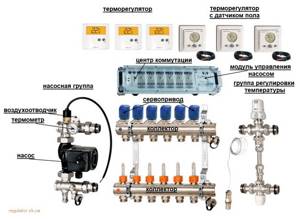
Heating system without thermostat
Many people are interested in whether it is possible to connect a heated floor directly without a thermostat. Experts say this could, in theory, be done by connecting the system to a regular switch. However, you will have to constantly monitor the temperature in the room to prevent overheating and damage to the equipment. It also consumes too much electricity, so this method is inconvenient and unprofitable.
Without a thermostat, the heater runs constantly, raising the room temperature to maximum and consuming unnecessary energy. When the sensors operate, only those resources that are necessary to achieve the recommended temperature are extracted and consumed. Heated floors without a regulator can be connected, but only for a short time, so that there is no network overload and overheating of the floor covering with subsequent damage.
Connecting a heated floor without a thermostat
When thinking about whether it is possible to connect a heated floor without a thermostat, you should find out not only the opinion of a specialist, but also inquire about the design features, connection specifics and functionality of the system.
It is important not only to feel comfortable when stepping on a heated floor, which should not be too hot or cold due to low heating.
It is necessary to take care of saving energy and, accordingly, your own money. All this can be achieved by following the established rules and following the recommendations of experienced craftsmen.
Temperature control
Thermostats for underfloor heating systems are available in many versions, ranging from a simple controller with a small wheel for manually setting the room temperature to a complex mini-computer with digital display and touch screen. There are also devices that are designed for a single room and thermostats that are used to regulate the temperature throughout the entire building at all times.
Many owners do not connect heated floors without a temperature sensor, even if this applies to electric mats, where self-regulation is possible. To control the temperature, thermostats are installed, which, using a built-in sensor, measure the actual value and adjust it according to the specified target parameters.
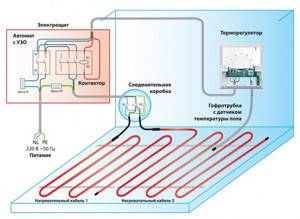
When choosing a model, you need to consider the installation location of the device. It should not be constantly exposed to direct sunlight or heat sources, as this will affect the temperature sensors. In addition, the thermostat should be placed so that it is always accessible and there is sufficient air circulation.
How to connect a heated floor to the electrical network
When installing an electric heated floor, the most labor-intensive part is connecting to the power supply. Installing floors directly with your own hands is not difficult even for beginners, but if the connection of an infrared heated floor, either cable or rod, is done incorrectly, the system will not perform its functions or will fail. You should pay attention to the grounding device, otherwise the system will “beat” with current.
Electric heated floors require the installation of a thermostat. This device is needed to maintain a stable set temperature in the room. The thermostat turns the floors off and on according to the temperature sensor readings.
Installing the Thermostat
Before installation, it is necessary to draw a sketch, where the location of the sensor should be planned at a distance of at least 50 cm from windows and doors and only on internal walls. Up to three heating mats can be connected to the device.
If a room's electric underfloor heating system requires more than three heating mats, calculate several thermostats accordingly. The sensor must be between two heating cables, use the existing power connections to connect the power cord.
During installation, you need to perform the following steps step by step:
- In the pre-drilled groove in the wall and floor, install the thermostat and heating mat cables.
- Then place the temperature sensor between them (the curvature of the line must have a radius of at least 6 cm).
- After cleaning the surface, it is recommended to prime the ceiling for better adhesion.
- After laying, press the mats firmly to the base for optimal fixation, and attach the thermostat to the contacts.
- Then you need to fill the space with screed.
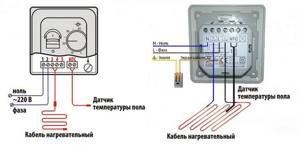
Before screeding and finishing work, you need to check the resistance with a multimeter. Before turning on the thermostat, you need to wait 8-10 days until the screed is completely dry.
The influence of the coolant supply method on the choice of control technology
Control of heating of water heated floors equipped with their own heat pumps occurs under conditions of continuous supply of coolant at high speed and in large volumes. Such systems use the admixture of cooled liquid to the supply stream to bring its energy parameters to the specified ones. The mixing is carried out in pumping and mixing units (PMU), which lower the temperature of the coolant from the primary high-temperature heating circuit to the design ones. Further adjustment of the temperature of the heated floor is carried out on the combs and has already been described above. NSU blocks provide optimal operating conditions for underfloor heating, and also allow it to be installed in unlimited areas.
However, with a small TP quadrature it is possible to avoid the use of expensive mixing units. The temperature of the coolant for the heated floor, in this case, is maintained by the method of limiting flows or by the RTL scheme. The functional principle of the circuit is the portion supply of coolant into the circuits. In each branch, the active element of the thermostatic valve, installed on the return line, having warmed up to the set temperature maximum, blocks the flow of working fluid. The heat gradually released by the coolant is dissipated in the concrete screed. After the system has cooled to the minimum temperature threshold, the valve opens and the batch feed cycle is repeated.

The simplicity of RTL control of underfloor heating makes it especially attractive. After all, it is enough to use a set of thermomechanical valves installed on the comb, or compact “unibox” type assemblies. However, when choosing an RTL scheme, you should not forget about its limitations:
- it is applicable only in heated floors made under a thick concrete screed, which plays the role of a heat accumulator;
- For efficient operation, in addition to good heat removal, the circuit pipelines must have minimal hydraulic resistance. This is necessary to quickly update the coolant. Taking into account the absence of a heat pump in the TP system, such conditions are met if the length of the branches does not exceed 50 m with a pipeline diameter of 16 mm. If it is necessary to slightly increase the length of the circuits, it is recommended to use pipes Ø 20 mm.
Important! The use of pipes of different diameters in one system (on one collector) of underfloor heating with RTL control is strongly not recommended.

